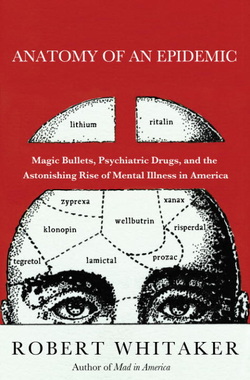
The book is by a man who founded a publishing company to report on the business aspects of clinical testing of new drugs… an “industry-friendly” enterprise. Baffled by studies suggesting the inefficacy of medications for patients with schizophrenia, he began an investigative journey that resulted in this book.
“Epidemic” is a strong word. How does Whitaker support it?
He starts by looking at the data for 1955, when the disabled mentally ill were primarily cared for in state and county mental hospitals. Today, these folks would typically be receiving SSI (Supplemental Security Income) or SSDI (Social Security Disability Insurance) payment, with many of them living in residential shelters or other subsidized living arrangements.

So let’s look at a more meaningful comparison, apples-to-apples. Let’s compare the number of folks on SSI and SSDI in 1987 to those in 2007. Why 1987? Because that’s the year that Prozac was approved by the FDA. Twenty years later, the rate for folks disabled by mental illness was 1 in 76 Americans. That’s more than double the rate in 1987.
Whitaker asks us to go deeper. In 1955, comparatively few of the people disabled by mental illness were diagnosed with major depression or bipolar illness. By 2006, 46 percent of young people (18-26 years old) on psychiatric disability were diagnosed with an affective illness, and 8 percent with anxiety disorder.
What about children? In 1987, pre-Prozac, only 5.5 percent of disabled children were diagnosed with psychiatric conditions. Twenty years later, that figure had changed to 50 percent. Today, mental illness is the leading cause of disability in children. And here’s an interesting statistic: Between 1996 and 2007, the number of children on SSI for other reasons (cancer, developmental disorders) declined, while the number on SSI for mental illness more than doubled. In other words, doctors seemed to be making progress in the treatment of other conditions, but losing some serious ground in combating mental illness.
Looking at these statistics, and especially those dating from the entry of Prozac into the marketplace, the author has the temerity to ask about the emperor’s new psychiatric clothes:
Could the current drug-based paradigm of care be causing this epidemic? In other words, is this epidemic iatrogenic in nature? (Etymology: Greek. iatros—physician, genein—to produce.) Is the theory of the “broken brain” actually a broken theory? Are the two decades of psychiatric drugging analogous to the two millennia of bloodletting—a pseudo-scientific practice rooted in the vulnerabilities of human nature, not medical science?
So here was Whitaker’s thinking: Since the general consensus is that millions of people are living better lives because of psychiatric medication, then surely the scientific literature should support this consensus with research into the biological disorders being treated and legions of studies reflecting the success of the new drugs.
In fact, the scientific literature tells an opposite story.
Click here to go back to Part 1.
Click here to read Part 3.

 RSS Feed
RSS Feed
